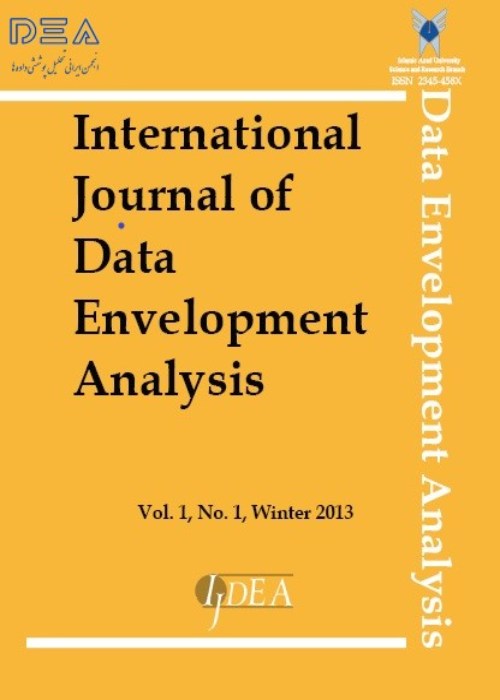فهرست مطالب
International Journal of Data Envelopment Analysis
Volume:2 Issue: 1, Jan 2014
- تاریخ انتشار: 1392/12/19
- تعداد عناوین: 6
-
Pages 291-302
Measuring the performance of a production system has been an important task in management for purposes of control, planning, etc. Lord Kelvin said :“When you can measure what you are speaking about, and express it in numbers, you know something about it; but when you cannot measure it, when you cannot express it in numbers, your knowledge is of a meager and unsatisfactory kind.” Hence, management knowledge is measurable science and if we can’t measure each subject we can’t control it so management is impossible. We know, the major criteria performance is productivity and we should be able to measure it. Data Envelopment Analysis (DEA), as an evaluation method, can estimate the relative efficiency of organizations systematically. The efficiency of an organization can be benchmarked by using DEA. DEA presents a model for evaluating the performance of a set of comparable decision making units (DMUs). In this paper we developed a new model for calculating productivity with Two-stage data envelopment analysis.
Keywords: Data envelopment analysis (DEA), Productivity, measuring performance, Two-Stage DEA, Effectiveness -
Pages 303-314
The need to establish power plants to supply the required electricity of the country has been rising due to increasing demand levels as well as the lack of governmental resources. Furthermore, the available traditional attitude in performing and conducting power plant projects has made government seek a modern attitude. This paper tries to use the topics that have been employed in automotive industry of the company for many years to detect and analyse failure reasons as well as the solutions that are suggested to prevent and improve them. The present study has used Failure Mode & Effects Analysis along with Data Envelopment Analysis to evaluate 17 failure modes of South Esfahan Power Plant. Severity, Occurrence and Detection are 3 failure factors considered in this study. Failure mode dealing with Scaling on rotor and diaphragms blades has the highest importance with the highest Risk Priority Number,Severity and its first grade.
Keywords: Evaluation, Risk, Failure mode, effects analysis (FMEA), Data envelopment analysis (DEA) -
Pages 315-322
The performance of a decision making unit (DMU) can be evaluated in either across-sectional or a time-series manner, and data envelopment analysis (DEA) is a useful method for both types of evaluation. The Malmquist productivity index (MPI) evaluates the change in efficiency of a DMU between two time periods. It is defined as the product of the Catch-up and Frontier-shift terms. In this paper, we study the Malmquist productivity index of a DMU between several time periods.
Keywords: Data Envelopment Analysis, Malmquist Productivity Index, Curve fitting -
Pages 323-332
Data Envelopment Analysis (DEA) has been long employed as a popular methodology to evaluate the performance of various production activities with multiple inputs and outputs. However, an important issue is that the production process in the real world inevitably generates undesirable outputs (like wastes and pollutants) along with desirable outputs. Therefore, the undesirable outputs should be included into the environmental performance evaluation. This study surveys the two technologies which is available in the DEA literature for modelling environmental performance under weak disposability assumption of good and bad outputs. Then, it attempts to present a Russell measure that incorporates both desirable and undesirable outputs. To illustrate the use of the proposed method, an empirical application corresponding to 31 administrative regions of China is provided and interpreted.
Keywords: Data Envelopment Analysis, Environmental performance, Undesirable Output -
Pages 333-341
Data Envelopment Analysis )DEA( is a technique for measuring the efficiency of decision making units. In all models of the DEA, for each unit under assessment, the numerical efficiency which may be less than or equal to one is obtained. Given the possible large number of efficiency units for evaluating units, we use various methods of ranking. span style="font-family: Cambria Math;font-size:8pt;color:rgb(0,0,0);font-style:normal;font-variant:normal L1 norm is one of the methods of ranking. This method has been used for categorical data. In this paper, we assume data as interval and introducespan style="font-family: Cambria Math;font-size:8pt;color:rgb(0,0,0);font-style:normal;font-variant:normal L1 norm andrun it on a single example.
Keywords: DEA, Ranking, Interval data, L1-norm -
Pages 343-350
Data Envelopment Analysis (DEA) is a mathematical programming-based approach for evaluates the relative efficiency of a set of DMUs (Decision Making Units). The relative efficiency of a DMU is the result of comparing the inputs and outputs of the DMU and those of other DMUs in the PPS (Production Possibility Set). Also, in Data Envelopment Analysis various models have been developed in order to evaluate the performance of decision-making units with negative data. The Modified Slack Based Measure (MSBM) model is from collective models family. This modified model is based on slack-based measure (SBM). Also the early models of data envelope analysis considered inputs and outputs as precise data. However, in studies about the data envelope analysis, some methods presented for applying imprecise data. Based on this, data envelope analysis models with interval data have been developed. In this paper, the MSBM model is investigated in presence of interval negative data, and then the efficiency of the model with imprecise data (interval) is evaluated. The efficiency of ten decision-making units is evaluated.
Keywords: Data Envelopment Analysis, modified model, Interval data, evaluating the efficiency of negative data


